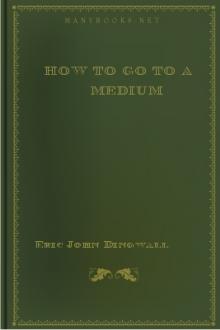Eric John Dingwall’s short 1927 book How to Go to a Medium: A Manual of Instruction contains much of value despite its vintage, though it is thin on detail. He wrote it while Research Officer at the Society for Psychical Research, during which period he gained extensive experience in sitting with mediums of all kinds. In particular, aided by his knowledge of conjuring, he had honed his ability to spot frauds. Maurice B. Wright, MD, who contributed the foreword, was a Council member of the SPR and on its medical committee, but not notable in survival research. He warns against gullibility on the part of sitters and praises Dingwall’s book as an attempt to warn of some of the pitfalls awaiting the unwary.
The book is written in a straightforward way, avoiding technical language, and is targeted mainly at the member of the public who wishes to contact a loved one, but also at the novice investigator who wants to establish whether or not genuine communications are being received. Crucially, Dingwall notes that even if the medium considers him- or herself to be sincere and is producing what appear to be genuine phenomena, it cannot be assumed communications are the result of a link between the medium and discarnate entities, as they could be originating in the minds of the living; at the very least coloured by the products of the medium’s subconscious.
The sitter should adopt a serious attitude and possess an open mind. Dingwall stresses the necessity for accurate observation and record keeping, and provides suggestions on the sorts of information which should be recorded. He occasionally states that reports of particular kinds should be sent to one of the Societies for Psychical Research (i.e. either the SPR or the American SPR) because they would be of particular interest, but disappointingly does not specify what the particular interest would be.
Working out the evidentiality of communications can be a problem, as degrees of acceptance vary from sitter to sitter. Mediums vary in quality and Dingwall stresses that indications of personal identity are key, not vague descriptions of the afterlife or semi-religious lectures. He covers a variety of methods used by mediums, dealing with mental and physical mediumship separately. In general, he considers the latter to be fraudulent, and in any case not providing the evidence for survival mental mediumship can.
The new sitter is reminded that mediums have often been operating for a long time, and it can be difficult to spot how fraud is being carried out. Knowledge of the techniques they use to persuade a sitter they are genuinely in communication with the dead cannot be learned quickly, and paranormal investigation is no different to other academic pursuits requiring a lengthy apprenticeship: ‘“Sitting” is an art which has to be learnt and many people fail altogether to learn from it and then wonder that they fail to get any good results.’
Investigators must not jump to conclusions based on thin evidence, nor assume that if he or she does not understand how information has been produced then spirits were responsible. They should be suspicious of mediums who claim phenomena are inhibited by sceptical sitters, or refuse reasonable requests for controlling them. Genuine mediums will be happy to collaborate with researchers and will not put spurious obstacles in their path.
Dingwall suggests methods that will help to minimise fraud and cold reading in séances, and an appendix deals with methods to control physical mediums (good light is highly recommended). Séances open to the general public are dismissed as unlikely to produce anything worthwhile, but even so, while there may be a great deal of fraud, the researcher can still learn something and perhaps have some enjoyment in the process.
Much of what Dingwall says is well worth taking on board, though the section devoted to physical mediums will be less consulted nowadays because of their scarcity, and one is unlikely to come across a spirit photographer using a plate camera. However, he could have elaborated his points without sacrificing accessibility. More on the tricks used by the unscrupulous would have been particularly welcome.
Even so, compared to the ever-expanding literature devoted to ‘ghost hunting’, guides providing sound advice on sitting with mediums are far fewer in number, so it is still worth consulting before booking a session. If it reminds those about to do so that to obtain results worth having they need to take stringent precautions and sift the evidence carefully, it will have proved its worth.

